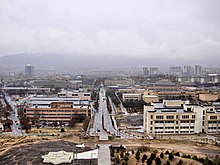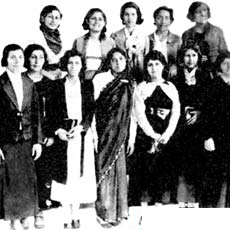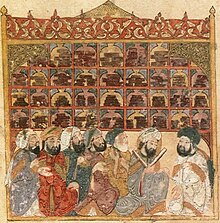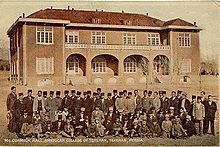Higher education in Iran



Iran has a network of private, public, and state-affiliated universities offering degrees in higher education. State-run universities of Iran are under the direct supervision of Iran's Ministry of Science, Research and Technology (for non-medical universities) and Ministry of Health and Medical Education (for medical schools). According to article 3 of the Constitution of the Islamic Republic of Iran, Iran guarantees "free education and physical training for everyone at all levels, and the facilitation and expansion of higher education." IANI representatives say that academics in Iran are "ultimately directed by the regime and military when it comes to specific areas of research". Rana Dadpour, who taught at an Iranian university, said that certain areas of research are directed by the Islamic Revolutionary Guard Corps and could be employed for "surveillance or military purposes".[2]
History
[edit]Pre-Islamic era
[edit]The existence of pre-Islamic era universities such as the School of Nisibis, Sarouyeh, Reishahr, and The Academy of Gundishapur provide examples of precedence of academic institutions of science that date back to ancient times.
Islamic era
[edit]
The traditions and heritage of these centers of higher learning were later carried on to schools such as Iran's Nizamiyya, and Baghdad's House of Wisdom, during the Islamic era. Nizamiyyah institutes were among the first well organized institutions of higher learning in the Muslim world. The quality of education was among the highest in the Islamic world, and they were even renowned in Europe. They were supported financially, politically, and spiritually by the royal establishment and the elite class. Some scholars have suggested that the establishment of the Nizamiyya madrasas was in fact an attempt to thwart the growing influence of another group of Muslims, the Ismailis, in the region. Indeed, Nizam al-Mulk devoted a significant section in his famous Books of Politics (Siyāsatnāma) to refuting the Ismaili doctrines.[4]
The most famous and celebrated of all the nizamiyyah schools was Al-Nizamiyya of Baghdad (established 1065), where Khwaja Nizam al-Mulk appointed the distinguished philosopher and theologian, al-Ghazali, as a professor. Persian poet Sa'di was a student of the Baghdad Nizamiyyah. Other nizamiyyah schools were located in Nishapur, Amol, Balkh, Herat and Isfahan.
Modern
[edit]It was Abbas Mirza who first dispatched Iranian students to Europe for a western education.[5]
The history of the establishment of western style academic universities in Iran (Persia) dates back to 1851 with the establishment of Darolfonoon – which was founded as a result of the efforts of the royal vizier Mirza Taghi Khan Amir Kabir, aimed at training and teaching Iranian experts in many fields of science and technology.[6]
In 1855 "The Ministry of Science" was first established, and Ali Gholi Mirza I'tizad al-saltaneh (علیقلی میرزا اعتضاد السلطنه) was appointed Iran's first Minister of Science by Nasereddin Shah.
By the 1890s Darolfonoon was competing with other prominent institutions of modern learning. The Military College of Tehran (Madraseh-ye Nezam), established in 1885 with a budget of 10,000-12,000 tomans, was its first rival; and in 1899 the College of political sciences (Madraseh-ye olum-e siyasi) was organized within the Foreign ministry.[7]
The Ministry of Higher Education, which oversees the operation of all institutes of higher education in Iran, was established in 1967. However, it was back in 1928 that Iran's first university, as we know it today, was proposed by an Iranian physicist, Mahmoud Hessaby. The University of Tehran (or Tehran University) was designed by French architect Andre Godard, and built in 1934. Today, Tehran University is Iran's largest university with over 32,000 students.
In the medical field, it was Joseph Cochran who first founded a professional school in Iran in 1878, and who is often credited for founding Iran's "first contemporary medical college",[8] as well as founding one of Iran's first modern hospitals ("Westminster Hospital") in Urmia formerly known as Rezaieh in honor of Shia Islam's 8th Imam. The medical faculty Cochran established at Urmia University was joined by several other Americans, namely Drs. Wright, Homlz, van Nourdon, and Miller. They were all buried in Urmia as their resting place after serving the area for many years.
In Tehran, Samuel M. Jordan, whom "Jordan Ave." in Tehran is named after, also was directly responsible for the expansion of the American College in Tehran. The school received a permanent charter from the Board of Regents of the State University of New York in 1932.[9]

By the end of the first Pahlavi period in 1941, the University of Tehran was still the only modern university in the country. Hence, the ministry of science commenced the establishment of other universities in Isfahan, Tabriz, Ahvaz, and Shiraz, with special emphasis given to the medical and veterinary sciences.[10] Charles Oberling was highly instrumental in this regard.[11]
In 1953, there were four universities with 14,500 undergraduate students whereas in 1977 there were 16 universities with 154,315 undergraduate students.[12]
The Shah soon initiated projects to build Iranian universities modeled after American schools. Thus Pahlavi University (Shiraz University today), Sharif University of Technology, and Isfahan University of Technology, three of Iran's top academic universities were all directly modeled on American institutions such as the University of Illinois at Chicago, MIT, and the University of Pennsylvania.[13][14] The Shah in return was generous in awarding American universities with financial gifts. For example, the University of Southern California received a gift from the Shah in the form of an endowed chair of petroleum engineering, and a million dollar donation was given to the George Washington University to create an Iranian Studies program.[13]
The Iranian revolution put an end to the massive US-Iran academic relations. In 1980, a major overhaul in the academia and higher education system of Iran initiated by Ayatollah Khomeini led to what is referred to in Iran as "Iran's Cultural Revolution". However, all universities in the country were closed down from 1980 to 1983.[15] In addition, Islamic curricula and Islamic educational setting were introduced when the universities were reopened.[15]
In 1986, the ministry of higher education handed over supervision and overseeing of education in the medical sciences in Iran to the ministry of health, treatment and medical education.[citation needed]
After the Iran–Iraq War, some new universities were founded and doctoral programs were developed in the previous universities. The number of university students is now more than six times as many as in 1979 (when Shah was overthrown), so that critics debate whether the national entrance exam is useful anymore or not.[citation needed]
Academic system of Iranian universities
[edit]
In 2008, Iran had over 3.5 million students enrolled in universities.[16] Some 1.7 million in various programs in Islamic Azad university and the remainder in State universities. In addition the new enrollment numbers for the academic year 2004 were 290 thousand in Azad universities, and 250 thousand in state universities. Iran has 54 state operated universities, and 42 state medical schools. These are primarily the top choice for students in national entrance exams. There are 289 major private universities operating as well.[17] In all these schools, except for private universities such as the Islamic Azad University system, tuition and room and board is mostly paid for by the government. The universities themselves largely operate on state budgets.[citation needed]
Some schools offer degrees in conjunction with European universities. The International University of Chabahar for example in 2007 offered programs under the guidance of London School of Economics and Political Science Goldsmiths University of London, and Royal Holloway.[18] Other schools such as the Institute for Advanced Studies in Basic Sciences in Zanjan, have close collaboration with The International Centre for Theoretical Physics in Trieste, Italy for workshops, seminars, and summer schools. The Iranian government also in 2017 offered scholarships for successful applicants to pursue PhD-level studies in foreign countries, mostly Great Britain.[19]
By early 2000, Iran allocated around 0.4% of its GDP to R&D, which ranks it "far behind industrialized societies" and the world average of 1.4%.[20] By 2009 this ratio of research to GDP reached 0.87% and the set target was 2.5%.[21]
Rankings
[edit]Six Iranian universities have been placed among the world’s top 1,000 universities announced by the Quacquarelli Symonds (QS) World University Rankings 2024. Times Higher Education World University Rankings published a global ranking for universities and institutes of higher education in 2024. The best global universities in Iran were ranked as follows:
Ranking by number of publications (ISI)
[edit]As per the data published on QS World University Rankings official website 2024, Sharif University of Technology, ranked 334, University of Tehran, ranked 360, Amirkabir University of Technology, ranked 375, Iran University of Science and Technology, ranked 451, Shiraz University, ranked between 681 and 690, Shahid Beheshti University, ranked between 951 and 1000, and Ferdowsi University of Mashhad, ranked between 1001 and 1200, are the top 7 Iranian universities among world-class universities.[citation needed]
Medical schools
[edit]ISC's most recent list of the highest-ranked universities in the medical field for 2012 is:[22]
- Tehran University of Medical Sciences
- Shiraz University of Medical Sciences
- Shahid Beheshti University of Medical Sciences (Former Melli University)
- Isfahan University of Medical Sciences
- Tabriz University of Medical Sciences
- Mashad University of Medical Sciences
- Ahvaz Jundishapur University of Medical Sciences
Dental schools
[edit]According to the 2007 rankings[23] the top five rated schools in the dental field in Iran are:
- Shahid Beheshti University of Medical Sciences
- Tehran University of Medical Sciences and Mashad University of Medical Sciences
- Isfahan University of Medical Sciences
- Kerman University of Medical Sciences and Shahid Sadoughi University of Medical Sciences and Health Services and Hamedan University of Medical Sciences
- Ahvaz Jundishapur University of Medical Sciences and Shiraz University of Medical Sciences and Babol University of Medical Sciences
Pharmacy schools
[edit]According to the 2010 rankings[24] the top three rated schools in the pharmaceutical field in Iran are:
- Tehran University of Medical Sciences
- Isfahan University of Medical Sciences
- Tabriz University of Medical Sciences
Engineering schools
[edit]According to the 2024 Times Higher Education World University Rankings the top-ranked engineering schools in the engineering field and their rank among world universities are:
- Sharif University of Technology 126
- University of Tehran 201
- Amirkabir University of Technology 251
- Iran University of Science and Technology 251
- University of Tabriz 301
- Babol Noshirvani University of Technology 401
- Imam Khomeini International University 401
- University of Kashan 401
- Shiraz University of Technology 501
- Shiraz University 501
- Isfahan University of Technology 501
- University of Mohaghegh Ardabili 501
- Urmia University 501
Prominent libraries in Iran
[edit]Large libraries existed in Iran both before and after the advent of Islam and throughout many periods in Iran's history, including the libraries at Gondeshapur, School of Nisibis, and Sarouyeh during the pre-Islamic era of Iran.
During the Middle Ages, many schools of Nizamiyya harbored large collections of manuscripts and treatises. In Maragheh, Nasīr al-Dīn al-Tūsī built a library that reportedly contained some 40,000 volumes which was well financed[25] and the royal library of the Samanid court in which Avicenna was granted special access to, is yet another fine example.[26]
The first prototype of a modern national library in Iran was the Library of Dar al-Funun College established in 1851. In 1899 another library called the Nation's Library was inaugurated in Tehran. Finally, the National Library of Iran was inaugurated in 1937.
Iran's major national libraries today are:
- National Library of Iran, Tehran
- Central Library of Astan Quds Razavi, Mashad
- Tabriz National Library, Tabriz
- Malek National Library, Tehran
- Ayatollah Marashi Najafi Library, Qom[27]
- Iran's Library of The Parliament[28]
- Shiraz Regional Library of Science and Technology, Shiraz
- Library of Institute for Studies in Theoretical Physics and Mathematics
Ideology and politics in higher education
[edit]Under the rule of the Islamic theocracy in Iran since 1979 revolution, the status of science and education has been dramatically affected in the country. In particular, following the so-called Iranian Cultural Revolution and Islamization of universities after a shutdown period,[15] the quality of science and technology has since been revived, so much so that Iran ranked 40th in science production and first in scientific growth in the world in 2011.[29]
Exclusion of students
[edit]Religious
[edit]Students of unrecognized minority religions have been barred from entering tertiary education institutions in Iran, particularly those of the Baháʼí Faith.[30] Since the Iranian Revolution of 1979 Baháʼí students have been excluded from universities regardless of their national university examination results on basis of their religion. See Baháʼí Institute for Higher Education.
Gender-based
[edit]Additionally, in August 2012, 36 universities declared that 77 BA and BSc courses in 2012–2012 academic year would be "single gender" and effectively exclusive to men, limiting the options of female undergraduate students.[31]
Entrepreneurship
[edit]In accordance with the third five-year development plan, the “entrepreneurship development plan in Iranian universities”, (known as KARAD Plan) was developed, and launched in twelve universities across the country, under the supervision of Management and Planning Organization and the Ministry of Science, Research and Technology.[32]
Brain drain and students abroad
[edit]Iran tops the world countries in the brain drain phenomenon. In 2002, the CIA estimated that 77% of Iran's population aged 15 and over can read and write.[33] By 2008, the adult literacy rate had reached 80.6%.[34] A significant majority of this population is at or approaching collegiate levels. Of this population, nearly 150,000 are estimated to exit Iran every year.[35][36]
According to the Iranian government, in 2013, 12,000 foreign students were studying at Iranian universities while 55,686 Iranian students were studying abroad.[37] Out of this number, 8,883 students were studying in Malaysia, 7,341 in the United States, 5,638 in Canada, 3,504 in Germany, 3,364 in Turkey, 3,228 in Britain, and the rest in other countries.[38][39] But according to a newer estimate by the Minister of education, between 350 and 500 thousand Iranians were studying outside of the country in 2014.[40] The difference remains unexplained. As of 2015, 42% of recent/young graduates were unemployed.[citation needed] As of 2020, 40,000 foreign nationals are studying in 43 Iranian universities, 22,000 of whom are studying at the universities affiliated to the Ministry of Science, 8,000 at the Azad University, 3,000 at the Ministry of Health, and the rest at other universities. Some 50 percent of these students are studying for a bachelor's degree and 16 percent of whom are educating to receive a Ph.D.[41]
See also
[edit]- Education in Iran
- Science and technology in Iran
- Economy of Iran
- International Rankings of Iran in Education
- List of Iranian Research Centers
- List of universities in Iran
- Iranian Studies
- Intellectual Movements in Iran
- Historic institutions
References
[edit]- ^ بدرالملوک بامداد، زن ایرانی از انقلاب مشروطه تا انقلاب سفید. تهران: ابنسینا، ۱۳۴۷. ص ۹۹
- ^ Yerushalmy, Jonathan (24 February 2024). "Where freedom meets repression: Australian academics tread a fine line over ties to Iran". The Guardian.
- ^ "ソムリエの資格はイタリア". Islamic-art.net. Archived from the original on 22 July 2015. Retrieved 8 February 2017.
- ^ Virani, Shafique N. The Ismailis in the Middle Ages: A History of Survival, A Search for Salvation (New York: Oxford University Press, 2007), 73.
- ^ Patrick Clawson and Michael Rubin. Eternal Iran. Palgrave Macmillan. 2005. ISBN 1-4039-6276-6 p. 34
- ^ Hassan pour, Faramarz (5 June 2014). "Design of Higher Education Learning Spaces in Iran; From the Qajar Period to the Present Time". Snapshots International Symposium on Learning Spaces, the University of Melbourne. doi:10.13140/2.1.2169.5040. hdl:11343/42271. S2CID 114653242.
- ^ "Encyclopædia Iranica". Archived from the original on 2007-11-17. Retrieved 2007-05-02.
- ^ "ARCHIVES OF IRANIAN MEDICINE". ams.ac.ir. Archived from the original on 28 September 2011. Retrieved 8 February 2017.
- ^ Lorentz, J. Historical Dictionary of Iran. 1995. ISBN 0-8108-2994-0
- ^ آموزش و پرورش در ایران (Education in Iran). Naser Takmil Homayoun. دفتر پژوهشهای فرهنگی (Center for Cultural Research Publications). p. 98
- ^ پروفسور ابرلن و نقش او در آموزش پزشکی نوین ایران (Dr. Charles Oberling and his role in Iran's modern medical education). شمس شریعت تربقان. TUMS Publications. 2007.
- ^ Abrahamian, Ervand (May 1980). "Structural Causes of the Iranian Revolution". MERIP Reports (87): 21–26. doi:10.2307/3011417. JSTOR 3011417.
- ^ a b "Trends by Region: MIDDLE EAST and Penn's Global Engagement, University of Pennsylvania University Archives". UPenn.edu. Archived from the original on 19 May 2011. Retrieved 8 February 2017.
- ^ Exporting MIT. Stuart W. Leslie and Robert Kargon. Osiris, volume 21 (2006), pp. 110–130 Link: [1]
- ^ a b c Paola Rivetti (February 2012). "Islamic republic: shaping Iran's politics through the campus". In Rouzbeh Parsi (ed.). Iran: A RevolutIonary RepublIc in TransItIon (Chaillot Papers). Paris: Institute for Security Studies European Union. ISBN 978-92-9198-198-4. Archived (PDF) from the original on 4 October 2013. Retrieved 27 July 2013.
- ^ يكتاوب, yektaweb. "موسسه پژوهش و برنامه ریزی آموزش عالی" (PDF). irphe.ir. Archived (PDF) from the original on 6 March 2009. Retrieved 8 February 2017.
- ^ History.htm Archived 2007-03-12 at the Wayback Machine
- ^ "دانشگاه بین المللی چابهار". Archived from the original on 2007-09-28. Retrieved 2007-08-15.
- ^ "اعزام و بورس دانشجویان". www.msrt.ir (in Persian). Archived from the original on 2017-01-25. Retrieved 2017-09-08.
- ^ "Medical Science and Research in Iran". ams.ac.ir. Archived from the original on 17 May 2017. Retrieved 8 February 2017.
- ^ "irantradelaw.com" (PDF). Archived from the original (PDF) on 10 March 2013. Retrieved 8 February 2017.
- ^ ur.isc.gov.ir Archived 2012-08-09 at the Wayback Machine
- ^ "رتبه بندي آموزشي دانشگاه ها و دانشكده هاي علوم پزشكي ايران (3- دانشکده های دندانپزشکی) : سایت پزشکان بدون مرز". Pezeshk.us. Archived from the original on 11 February 2017. Retrieved 8 February 2017.
- ^ "رتبه بندي آموزشي دانشگاه ها و دانشكده هاي علوم پزشكي ايران (2-دانشكده هاي داروسازي ) : سایت پزشکان بدون مرز". Pezeshk.us. Archived from the original on 13 January 2017. Retrieved 8 February 2017.
- ^ S. H. Nasr, Oliver Leaman. History of Islamic Philosophy. Vol I. ISBN 0-415-25934-7. 1993. p. 542
- ^ A History of Medicine. Ralph H. Major. Vol 1. Charles C. Thomas Publishers. 1954. p. 242
- ^ "کتابخانه بزرگ آيتالله العظمى مرعشى نجفى". marashilibrary.com. Archived from the original on 30 March 2002. Retrieved 13 January 2022.
- ^ "Professional Manufacturers & Suppliers from China". MajlisLib.com. Archived from the original on 29 December 2001. Retrieved 8 February 2017.
- ^ Keddie, Modern Iran, (2003), p. 290
- ^ "New tactic obstructs Baháʼí enrollments in Iranian universities – Baháʼí World News Service". Bahai.org. 31 January 2008. Archived from the original on 11 February 2017. Retrieved 8 February 2017.
- ^ Tait, Robert (20 August 2012). "Anger as Iran bans women from universities". The Telegraph. Archived from the original on 20 August 2012. Retrieved 21 August 2012.
- ^ 20140429102612_IranEntrepreneurshipEcosystemReport-IEA2013-v2.pdf[usurped]
- ^ "The World Factbook — Central Intelligence Agency". CIA.gov. Retrieved 8 February 2017.
- ^ "Iran – Literacy rate". IndexMundi.com. Archived from the original on 25 March 2017. Retrieved 8 February 2017.
- ^ Harrison, Frances (8 January 2007). "Huge cost of Iranian brain drain". BBC News. Archived from the original on 9 January 2007. Retrieved 8 January 2007.
- ^ [BBC: http://news.bbc.co.uk/2/hi/middle_east/6240287.stm Archived 2012-03-29 at the Wayback Machine 6240287.stm]
- ^ "12,000 foreign students studying at Iranian universities". Payvand.com. Archived from the original on 17 April 2017. Retrieved 8 February 2017.
- ^ "14,000 foreign students studying in Iran". Payvand.com. Archived from the original on 24 October 2016. Retrieved 8 February 2017.
- ^ Coughlan, Sean (23 June 2015). "US universities on symbolic visit to Iran". BBC News. Archived from the original on 5 January 2017. Retrieved 8 February 2017.
- ^ "Over 350,000 Iranians studying abroad: Education Minister". Payvand.com. Archived from the original on 24 October 2016. Retrieved 8 February 2017.
- ^ "40,000 foreign nationals are studying in 43 Iranian universities". 13 November 2020.
External links
[edit]- Official
- Ministry of Health and Medical Education – Research Branch Archived 2012-01-12 at the Wayback Machine
- Islamic Republic of Iran Academy of Sciences
- Islamic Republic of Iran International Center for Dialogue Among Civilizations
- Tehran Education Organization (Amuzesh Parvaresh)
- Islamic Republic of Iran Academy of Persian Language and Literature
- Islamic Republic of Iran Academy of Medical Sciences
- Islamic Republic of Iran Cultural Heritage Organization
- Iran Scientific Information and Documentation Center
- Iran's Presidential Office of Scientific and Industrial Studies
- Iranian Nano-Technology Initiative Archived 2008-06-30 at the Wayback Machine
- Allameh Tabatabaee University
- Other
